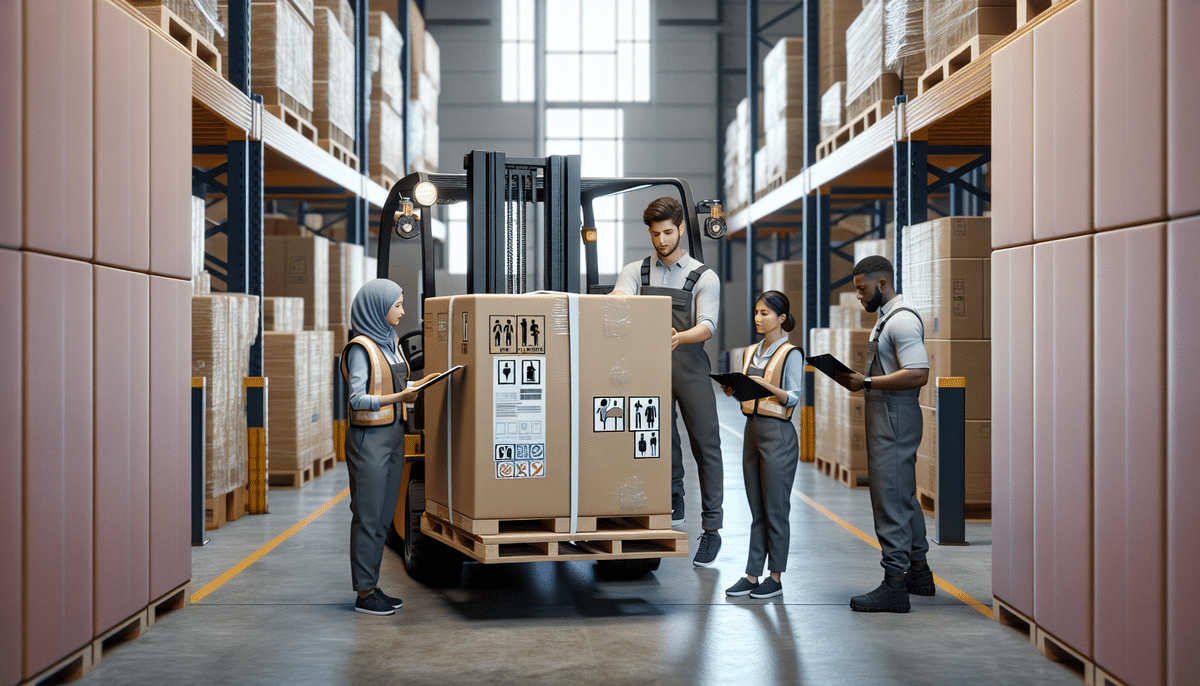How to Handle Packages Over 130 Inches with Additional Care
Moving and transporting packages can be a challenging task, especially when dealing with oversized packages that require special attention. Packages that measure over 130 inches in length and girth demand extra care as they pose significant risks if not handled safely. In this article, we will discuss in detail how to handle packages over 130 inches with additional care.
Understanding the Risks of Mishandling Large Packages
Large packages are difficult to handle and carry, increasing the likelihood of accidents and injuries. Mishandling them can lead to a multitude of hazards and risks, including:
- Exceeding Weight Limits: Oversized packages may surpass maximum weight thresholds, causing potential harm to handlers and those nearby.
- Dropping and Damage: The risk of dropping large packages is higher, which can damage the goods inside and injure individuals in the vicinity.
- Space Consumption: Large packages occupy more space, leading to poor storage practices and potential damage to surrounding freight.
Moreover, mishandling large packages can result in delays and additional costs. Damaged packages may need to be repackaged or replaced, causing delivery delays and increased expenses for the sender. Workplace injuries from improper handling can also lead to lost productivity and higher workers' compensation claims.
To mitigate these risks, it is crucial to properly train handlers on safe lifting and carrying techniques. Handlers should use methods such as bending at the knees, keeping the back straight, and wearing appropriate personal protective equipment like gloves and safety shoes. Awareness of weight limits and the use of equipment like dollies or forklifts are essential in safely moving large packages.
Best Practices for Handling Oversized Packages
Implementing best practices is essential for safely managing oversized packages:
- Use Mechanical Equipment: Employ forklifts, hand trucks, or pallet jacks to provide stability and reduce the physical strain on handlers.
- Wear Protective Gear: Ensure that all handlers wear gloves, safety shoes, and other necessary protective equipment.
- Maintain Good Posture: Encourage handlers to lift with their legs, not their backs, to minimize injury risks.
- Check Weight and Dimensions: Assess the package's weight and size before moving to determine the appropriate equipment and prevent accidents.
- Inspect for Fragile Items: Identify any fragile or hazardous items within the package and handle them with extra care.
- Effective Communication: Maintain clear communication among team members and supervisors, and follow company-specific handling protocols.
How to Properly Measure Large Packages for Safe Handling
Accurate measurement of large packages is critical to ensure safe handling and transportation:
- Use Appropriate Tools: Utilize measuring tapes or measuring wheels to accurately determine the length, width, and height of the package.
- Account for Protrusions: Include any handles, wheels, or other protrusions in the measurements to get a true representation of the package size.
- Weigh the Package: Use a reliable scale to measure the package's weight, ensuring it falls within the transportation method's weight limits.
- Proper Labeling: Clearly label the package with its dimensions and weight to facilitate correct handling and storage.
Accurate measurements prevent issues during transportation, such as space constraints and unsafe handling practices. Proper labeling also aids in quick identification and correct placement during loading and unloading.
Essential Tools and Equipment for Safely Moving Large Packages
Utilizing the right tools and equipment is vital for the safe movement of oversized packages:
- Mechanical Aids: Forklifts, hand trucks, and pallet jacks are indispensable for moving heavy and large items efficiently.
- Protective Materials: Strapping, banding, shrink-wrapping, foam, and bubble wrap help secure and protect the contents during transit.
- Dollies: Sturdy and reliable dollies come in various sizes and shapes, making it easier to move items across different terrains and spaces.
Additionally, proper training on lifting techniques is essential to prevent injuries. Workers should be educated on safe lifting practices, including bending at the knees, keeping the back straight, and using the legs to lift heavy objects.
Preparing the Packaging Materials for Extra Protection
Proper packaging ensures that large items are protected during transportation:
- Use Sturdy Boxes: Opt for corrugated boxes that can support the weight and size of the contents.
- Cushioning Materials: Incorporate bubble wrap, foam, or other cushioning materials to absorb shocks and prevent damage.
- Secure the Contents: Use strapping, banding, and shrink-wrapping to immobilize the contents and prevent movement during transit.
- Clear Labeling: Mark packages with visible labels indicating contents, destination, and handling instructions to ensure careful handling.
- Tamper-Evident Packaging: Consider using tamper-evident materials to protect against unauthorized access during transit.
Proper packaging not only protects the goods but also ensures compliance with transportation regulations and standards.
How to Lift and Move Large Packages without Straining Your Body
Preventing physical strain and injury when handling large packages involves:
- Proper Lifting Techniques: Bend at the knees, keep the back straight, and use the legs to lift rather than the back.
- Avoid Sudden Movements: Move slowly and avoid jerking or twisting motions that can lead to injury.
- Assess Before Moving: Evaluate the weight and size of the package to determine if mechanical assistance is needed.
- Clear Pathways: Ensure that the route is free of obstacles to prevent tripping or collisions.
- Use Mechanical Aids: Utilize dollies, hand trucks, or forklifts when necessary to reduce physical strain.
- Take Breaks: Avoid overexertion by taking regular breaks during extended handling tasks.
Implementing these practices reduces the risk of musculoskeletal injuries and promotes a safer working environment.
Tips for Loading and Unloading Oversized Packages from Vehicles
Efficiently loading and unloading large packages requires careful planning and technique:
- Enlist Help: Having additional handlers assists in managing heavy and bulky packages safely.
- Ensure Adequate Space: Verify that the vehicle can accommodate the package's dimensions to prevent shifting during transit.
- Use Proper Lifting Techniques: Lift with the legs, avoid twisting, and use mechanical aids when necessary.
- Inspect for Damage: Check both the package and vehicle for any pre-existing damages before proceeding.
- Secure the Package: Use straps or ropes to immobilize the package, preventing movement and potential damage during transportation.
- Wear Safety Gear: Gloves and sturdy shoes help protect against injuries during handling.
Proper loading and unloading practices ensure the safety of both the handlers and the integrity of the packages during transportation.
Managing Extra Care when Transporting Large Packages Long-Distance
Long-distance transportation of oversized packages demands additional precautions:
- Secure and Cushion Adequately: Ensure that packages are well-secured and cushioned to withstand the rigors of extended transit.
- Select Appropriate Transportation Modes: Choose transportation methods that minimize handling and reduce the risk of damage.
- Plan the Route: Opt for routes that avoid rough terrains and extreme weather conditions to protect the package.
- Weather Considerations: Use waterproof packaging materials and avoid transportation during adverse weather events to safeguard the contents.
- Monitor Shipments: Utilize tracking systems to monitor the package's status and make necessary adjustments in real-time.
By addressing these factors, handlers can ensure the safe and timely delivery of oversized packages over long distances.
Preventing Damage During Transit with Proper Stacking and Securing Techniques
Effective stacking and securing are crucial in preventing transit damage:
- Firm Stacking: Stack packages securely to prevent tumbling and ensure stability during movement.
- Use Strapping and Banding: Secure packages with strapping and banding to minimize movement during transit.
- Proper Cushioning: Incorporate cushioning materials to protect contents from impacts and vibrations.
- Even Weight Distribution: Distribute weight evenly across pallets or containers to prevent imbalances that could lead to tipping.
- Adhere to Weight Limits: Ensure that the total weight does not exceed the container or pallet's capacity to avoid structural failures.
- Clear Labeling: Provide clear labels with handling instructions and destination details to guide proper handling.
Implementing these techniques enhances the safety and integrity of packages during transit, reducing the likelihood of damage and ensuring successful deliveries.
What to Do When a Package is Damaged Despite Extra Care Precautions
Despite taking all necessary precautions, damage may occasionally occur during transit. In such cases, follow these steps:
- Document the Damage: Take clear photographs of the damaged package and its contents as evidence.
- Report Immediately: Notify the relevant authorities and insurance companies promptly to initiate compensation claims.
- Follow Company Procedures: Adhere to your organization's protocols for handling damaged goods, including filling out necessary forms and providing detailed reports.
- Assess the Damage: Determine the extent of the damage to decide whether the package needs to be repackaged, repaired, or replaced.
- Communicate with Stakeholders: Inform the sender and recipient about the damage and the steps being taken to resolve the issue.
Timely and effective handling of damaged packages ensures accountability and facilitates swift resolution, maintaining trust between all parties involved.
Common Mistakes to Avoid When Handling Oversized Packages
Avoiding common mistakes is key to safely managing oversized packages:
- Exceeding Weight Limits: Never lift or move packages that surpass established weight thresholds without appropriate assistance or equipment.
- Jerky Movements: Avoid sudden or uncontrolled movements that can lead to accidents or package damage.
- Ignoring Package Height: Be cautious of overhead structures and ensure that the package height does not cause collisions or obstructions.
- Lack of Communication: Failing to communicate effectively with team members can result in mishandling and increased risk of accidents.
- Poor Planning: Neglecting to plan the handling process can lead to inefficiencies and potential safety hazards.
By recognizing and avoiding these pitfalls, handlers can significantly reduce the risk of injuries and ensure the safe transportation of oversized packages.
Understanding the Legal Obligations of Companies in Handling Large Packages
Companies are legally obligated to ensure the safe and proper handling of large packages. Key legal considerations include:
- Compliance with OSHA Standards: Adhere to the Occupational Safety and Health Administration (OSHA) regulations to ensure workplace safety during package handling.
- DOT Regulations: Follow the Department of Transportation (DOT) guidelines for transporting oversized and heavy packages to avoid legal penalties.
- Worker Training: Provide adequate training to employees on safe handling practices to meet legal safety requirements.
- Proper Documentation: Maintain accurate records of package handling procedures, incidents, and compliance efforts.
- Liability Insurance: Secure appropriate insurance coverage to protect against potential claims related to package handling and transportation.
Failure to comply with these regulations can result in substantial fines, legal liabilities, and damage to the company's reputation. Prioritizing compliance ensures not only legal adherence but also the safety and well-being of employees and clients.
The Importance of Training Employees on Properly Handling Oversized Packages
Employee training is paramount in ensuring the safe handling of oversized packages:
- Skill Development: Train employees in correct lifting techniques and the use of mechanical aids to prevent injuries.
- Safety Protocols: Educate employees on company-specific safety protocols and regulatory compliance requirements.
- Equipment Training: Provide hands-on training for using equipment like forklifts, pallet jacks, and dollies efficiently and safely.
- Risk Awareness: Enhance workers' awareness of potential hazards associated with handling large packages and strategies to mitigate them.
- Continuous Education: Implement ongoing training programs to keep employees updated on best practices and new safety guidelines.
Well-trained employees are essential for maintaining a safe working environment, reducing the risk of accidents, and ensuring the integrity of the packages being handled.
Conclusion: Safely Delivering Large Items with Additional Care
In conclusion, moving and transporting oversized packages requires meticulous care and attention to safeguard both the package and its contents. Adhering to best practices, utilizing appropriate tools and equipment, and ensuring employee training are critical components in managing this task effectively. Additionally, compliance with safety regulations and proper handling techniques minimize the risk of damage and injury, ensuring the successful delivery of large items. By implementing these strategies, companies can enhance their operational efficiency, reduce costs associated with damaged goods, and maintain a reputable standing in the logistics and transportation industry.








